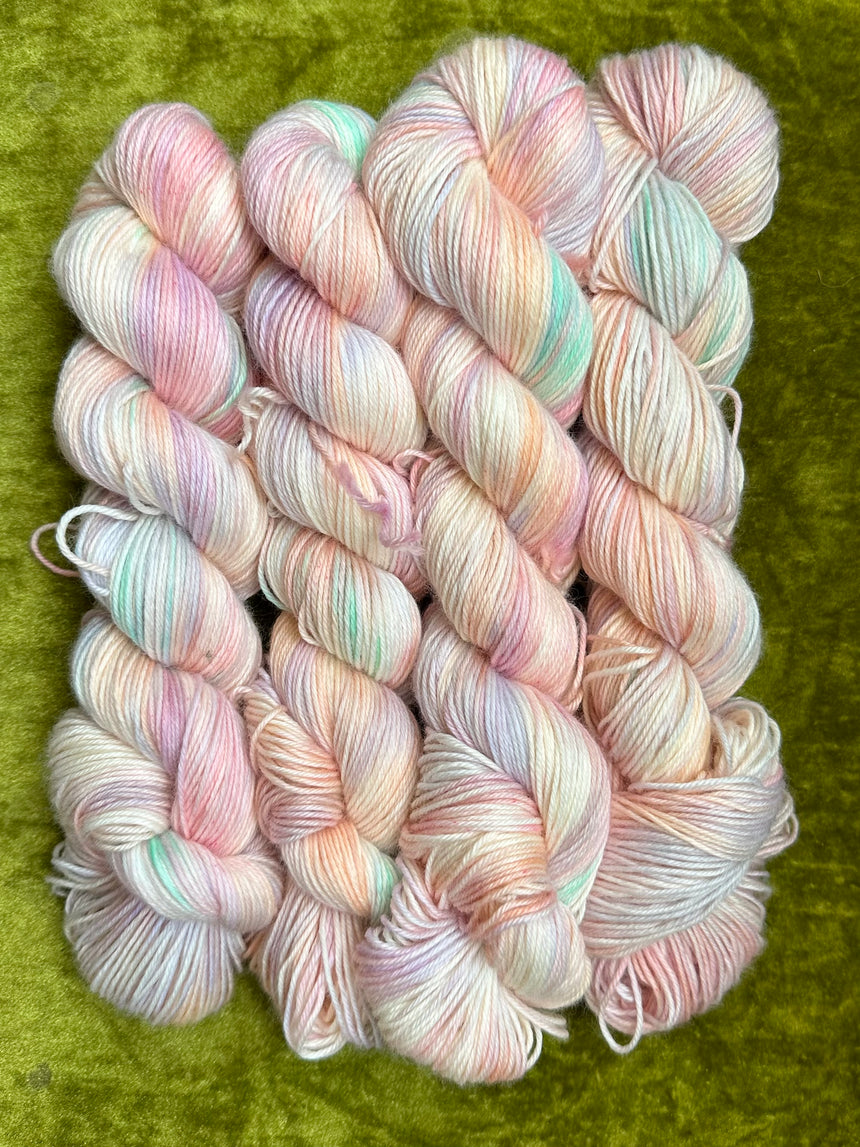Opal
$6.00For October, we have the weirdest gemstone - Opal! Did we have a hard time dyeing this one in a way that reflected what we want? Yes, but that seems on the nose for a gem where the synthetic version barely holds a candle to the nature-created stone.
The name opal is believed to be derived from the Sanskrit word upala, which means 'jewel', and later the Greek derivative opállios.
Opals come in two broad classes - common and precious. When you're picturing an opal, it is definitely the precious variety, which has the iridescence that makes them basically impossible to capture as a synthetic (or a yarn). Opals can come in pretty much any color, with black being the rarest and white, grey, and green being the most common.
Opal was considered a stone that could provide great luck because it was believed to possess all the virtues of each gemstone whose color was represented in the color spectrum of the opal. It was also seen as the patron gemstone of thieves during the same time period because it was said to grant invisibility if wrapped in a fresh bay leaf and held in the hand. The novel Anne of Geierstein by Sir Walter Scott changed the reputation to associate the gemstone with bad luck and death, and there are some superstitions saying that if an opal is offered among other goods for sale - don't buy anything more, as the opal embodies the evil eye.
Chemically, opals are a hydrated amorphous form of silica, with upwards of 21% of their weight being from water (but usually between 6-10%). Yep! Wet, shiny rocks!! Until opal deposits were found in Australia (where they are now the national gemstone), opals were only found in Slovakia. They were very rare and valuable, prized by European royals. The state of South Australia has 80% of the world's supply of opals. Ethiopia, some states in the US, Hungary, Slovakia, Mexico, Brazil and Indonesia also have opal deposits... as well as Mars!
Opals can also be found as fossils!! Petrified wood can be opalized, where the wood has developed an opalescent sheen or, more rarely, completely replaced by opal.
Synthetic/lab created opals were first created in 1974, but unlike other lab created stones, are much easier to tell apart from their inspirations based on the structure of the stones, and because synethic opals don't fluoresce under blacklight.
Like true Opals, our yarn is hard to capture. Hints of pink, orange, purple, and green all play together in pastels of this color. We think it'd be stunning in mohair over a darker tonal and we'll be sure to include pairings as we discover them!
BASES:
Chester Sock Mini Skein: 20g, 87 yards, 75% super wash merino/25% nylon
Hattie Floof: 50g, 437 yards, 70% Superkid mohair/30% silk (lace weight)
Chester Sock: 100g, 437 yards, blend of 75% superwash merino/25% nylon
Sabrina Sock: 100g, 432 yards, blend of 80% US sourced non-super wash merino/20% silk
Tortie Sport: 100g, 287 yards, 80% alpaca/20% silk
Minnie DK: 100g, 246 yards, 100% superwash merino wool
Genny Worsted: 100g, 191 yards, 80% superwash merino/20% alpaca
Chubby Trevor: 115g, 136 yards, 100% superwash merino
Chunky Trevor: 150g, 82 yards, 100% superwash merino, single ply
Summer Fingering: 65% silk/35% linen, 115g skein, approximately 438 yards
Summer DK: 65% silk/35% linen, 115g skein, approximately 246 yards
Summer Worsted: 65% silk/35% linen, 115g skein, approximately 181 yards
Gladys Fiber: 80% Shaniko Wool/20% Tussah Silk, approximately 4oz braid of fiber for spinning, felting, etc




